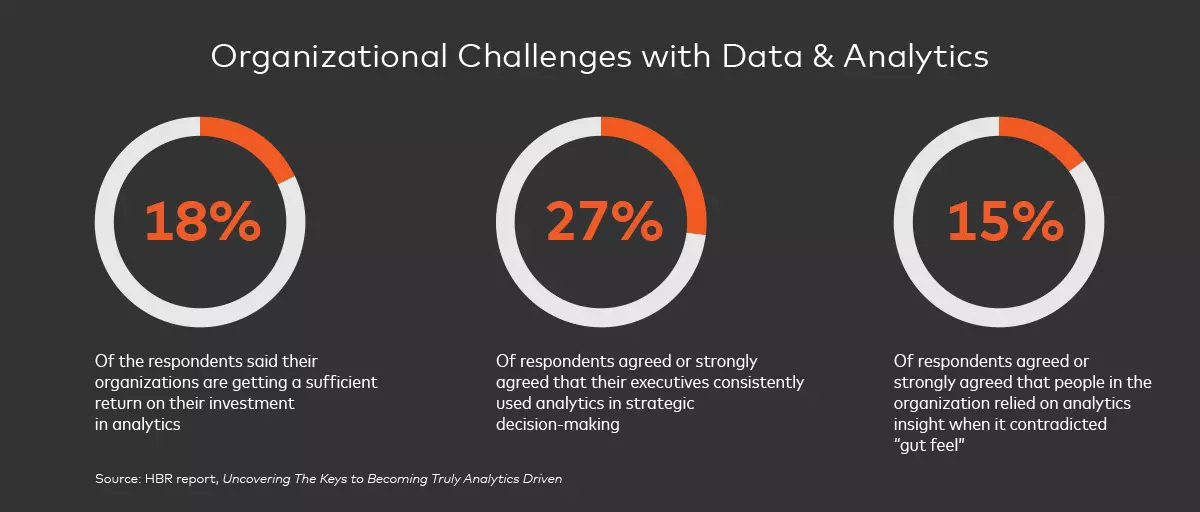By: Greg Ulrich
Published: August 22, 2019 | Updated: February 22, 2024
Read time: 5 minutes
Leading organizations get the most out of analytics program by increasing employee access to insights and democratizing data
Access to insights no longer requires a team of data scientists and statisticians. The democratization of insights has become an increasingly essential component of informed decision-making. When implemented correctly, it allows employees across the organization—including those without a technical background—to access, interpret, and use relevant insights to make important business decisions.
Democratizing data is relatively complex; it requires the right analytical platforms, employee training, and in many cases, a cultural shift. In most organizations, only designated analysts have regular access to insights. In fact, according to a recent Mastercard-sponsored survey by Harvard Business Review Analytic Services, less than one-fifth (18%) of the respondents said their organizations are getting a sufficient return on their investment in analytics. Only 27% of respondents agreed or strongly agreed that their executives consistently used analytics in strategic decision-making. And even fewer (15%) agreed or strongly agreed that people in the organization relied on analytics insight when it contradicted “gut feel.”
Democratizing data is a key component to changing the way we make decisions. For example, in a leading retailer or airline, a consumer insights team could shed light on trends in consumer behavior that affect not only the marketing team’s decisions, but also the real estate team’s planning decisions and the customer service team’s execution of day-to-day support. Giving more employees the tools they need to generate data-driven insights, and creating a central focus around the importance of analytics—whether it be through an analytics center of excellence or otherwise—is key to inspiring this type of work across the organization, from real estate to customer service, marketing, and more.

Preparing Teams
Thoughtfully democratizing data will limit risk to the organization and continue to build momentum for the initiative. Small wins, particularly in areas where inadequate access to insights is causing bottlenecks or confusion, can help generate support for broader democratization efforts. For example, creating a more open flow of communication between the analytics and consumer insights teams can create new ideas for the business: What are the analytics and consumer insights teams seeing that may impact decisions in other departments? How do these teams serve as a guiding force to empower departments with insights rather than simply fulfill requests coming from key stakeholders? Ultimately, this type of communication will encourage more groups to use insights in their day-to-day work and open the door for more direct use of insights over time.
Without a phased approach to data democratization, greater access to insights may cause confusion and do little to improve performance. Employees need to learn not only what insights are available to them, but also how they can analyze them and use them to impact their decisions.
Employing Scalable Analytics
Better analytics platforms have made even the most complicated analyses much simpler. Easy-to-use, scalable analytics software platforms enable the entire organization to access the insights they need without extensive training. Intuitive learning platforms or self-service training opportunities can also help your employees stay up to speed with new software or features and expand the use of analytics to multiple parts of the organization over time.
For organizations without a culture of leveraging data and analytics, the type of analytics center of excellence mentioned above can serve as experts and guide the organization in their analyses. The center of excellence can jump-start the successful use of data and analytics for the organization.
Measuring Results
In the Mastercard-sponsored HBR report, nearly two-thirds of organizations who saw a high return on analytics investments said they were able to effectively measure the impact of analytics on their key performance indicators (KPIs). If organizations aren't drawing a direct comparison between their analytics strategies and their business goals, they won't be able to identify where their investments are paying off and where they can improve. And, without that payoff, data and analytics that provides only “interesting insights” won’t catch on.
In all, data is no longer the exclusive reserve of data scientists. With the right approach and the power of best-in-class, scalable analytics platforms, organizations can learn to use insights to improve communication, streamline decision-making, and deliver on KPIs across the organization to achieve a competitive advantage.










